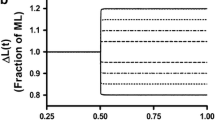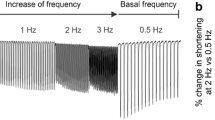Abstract
Myocytes were isolated from rat heart ventricles and then incubated with [32P]-sodium phosphate to label intracellular ATP stores. Incubations of the [32P]-labelled cardiomyocytes with a b-adrenoceptor agonist isoproterenol (10 µM) and with a plant diterpene forskolin (100 µM) which directly stimulates adenylyl cyclase increased the phosphorylation of an inhibitory subunit of troponin (TN-I) and phospholamban (PLN). Brief exposure (1 min) of labelled myocytes to the hydroxyl radical generating system (H2O2 plus FeCl2) decreased markedly the stimulatory action of isoproterenol and forskolin on TN-I and PLN phosphorylation. Similar exposure of myocytes to 5-5′-dithiobis-nitrobenzoic acid (DTNB) a sulfhydryl oxidizing reagent exerted little inhibitory effect on the isoproterenol or forskolin stimulated TN-I and PLN phosphorylation. In contrast exposure of myocytes to low concentrations (< 50 µM) of N-ethylmaleimide (NEM) a sulfhydryl alkylating reagent augmented the stimulatory effect of isoproterenol on TN-I and PLN phosphorylation. The results further showed that brief treatment of myocytes to H2O2 plus FeCl2 markedly decreased isoproterenol-, but not forskolin-, stimulated cyclic AMP accumulation in the myocytes. The stimulatory action of NEM on the isoproterenol-stimulated TN-I and PLN phosphorylation appeared related to greater increase in the isoproterenol-stimulated cyclic AMP accumulation in the NEM-treated cardiomyocytes. The results are consistent with the postulate that hydroxyl radical exposure of cardiomyocytes blunts the β-adrenoceptor-mediated stimulation of adenylyl cyclase leading to decreased phosphorylation of TN-I and PLN and imply that such alterations account in part the reported depressed rate of relaxation of the myocardium exposed to oxygen free radicals. (Mol Cell Biochem 175: 99–107, 1997)
Similar content being viewed by others
References
Osterrieder W, Brum G, Hescheler J, Trautwein W, Flockerzi W, Hofmann F: Injection of subunits of cyclic AMP-dependent protein kinase into cardiac myocytes modulates Ca2+ current. Nature 298: 576–578, 1982
Sperelakis N, Wahler GM: Regulation of Ca2+ influx in myocardial cells by beta adrenergic receptors cyclic nucleotides and phosphorylation. Mol Cell Biochem 82: 10–28, 1988
Tada M, Kirchberger MA, Repke DI, Katz AM: The stimulation of calcium transport in cardiac sarcoplasmic reticulum by adenosine 3?:5?-monophosphate-dependent protein kinase. J Biol Chem 249: 6174–6180, 1974
Tada M, Katz AM: Phosphorylation of the sarcoplasmic reticulum and sarcolemma. Ann Rev Physiol 44: 401–423, 1982
Ray KP, England PJ: Phosphorylation of the inhibitory subunit of troponin and its effect on the calcium dependence of cardiac myofibril adenosine triphosphatase. FEBS Lett 70: 11–16, 1976
Robertson SP, Johnson JD, Holroyde MJ, Kranias EG, Potter JD, Solaro RJ: The effect of troponin I phosphorylation on the Ca2+-binding properties of the Ca2+-regulatory site of bovine cardiac troponin. J Biol Chem 257: 260–263, 1982
Katz AM, Tada M, Kirchherger MA: Control of calcium transport in the myocardium by the cyclic AMP-protein kinase system. Adv Cyclic Nucleotide Res 5: 453–472, 1975
Zhang R, Zhao J, Mandveno A, Potter JD: Cardiac troponin I phosphorylation increases the rate of cardiac muscle relaxation. Circ Res 76: 1028–1035, 1995
Sulakhe PV, Jagadeesh G, Braun AP: In: H Rupp (ed). The Regulation of Heart Function. George Thieme Verlag, Stuttgart, 1986 pp 71–94
Burton KP: Evidence of direct toxic effects of free radicals on the myocardium. Free Rad Biol Med 4: 15–24, 1988
Kloner RA: Introduction to the role of oxygen radicals in myocardial ischemia and infarction. Free Rad Biol Med 4: 5–7, 1988
Singal PK, Dhalla AK, Hill M, Thomas TP: Endogenous antioxidant changes in the myocardium in response to acute and chronic stress conditions. Mol Cell Biochem 129: 179–186, 1993
Zweier JL, Flaherty JT, Weisfeldt ML: Direct measurement of free radical generation following reperfusion of ischemic myocardium. Proc Natl Acad Sci USA 84: 1404–1407, 1987
Maupoil V, Rochette L: Evaluation of free radicals and lipid peroxide formation during global ischemia and reperfusion in isolated perfused rat heart. Cardiovasc Drugs Ther 2: 615–621, 1988
Prasad K, Kalra J, Chan WP, Chaudhary AK: Effects of oxygen free radicals on cardiovascular function at organ and cellular levels. Am Heart J 117: 1196–1202, 1989
Prasad K, Kalra J, Chaudhary AK, Debnath D: Effects of polymorphonuclear leukocyte-derived oxygen free radicals and hypochlorous acid on cardiac function and some biochemical parameters. Am Heart J l 19: 538–550, 1990
Hess ML, Okabe E, Kontos HA: Proton and free oxygen radical interaction with the calcium transport system of cardiac sarcoplasmic reticulum. J Mol Cell Cardiol 13: 767–772, 1981
Okabe E, Hess ML, Oyama M, Ito H: Characterization of free radicalmediated damage of canine cardiac sarcoplasmic reticulum. Arch Biochem Biophys 225: 164–177, 1983
Kukreja RC, Okabe E, Schrier GM, Hess ML: Oxygen radical-mediated lipid peroxidation and inhibition of Ca2+-ATPase activity of cardiac sarcoplasmic reticulum. Arch Biochem Biophys 261: 447–457, 1988
Kaneko M, Beamish RE, Dhalla NS: Depression of heart sarcolemmal Ca2+-pump activity by oxygen free radicals. Am J Physiol 256: H368–H374, 1989
Kaneko M, Matsumoto Y, Hayashi H, Kobayashi A, Yamazaki N: Oxygen free radicals and calcium homeostasis in the heart. Mol Cell Biochem 139: 91–100, 1994
Kryski A Jr, Kenno KA, Severson DL: Stimulation of lipolysis in rat heart myocytes by isoproterenol. Am J Physiol 248: H208–H216, 1985
Sulakhe PV, Vo XT: Regulation of phospholamban and troponin-I phosphorylation in the intact rat cardiomyocytes by adrenergic and cholinergic stimuli: roles of cyclic nucleotides, calcium, protein kinases and phosphatases, and depolarization. Mol Cell Biochem 149/150: 103–126, 1995
Laemmli UK: Cleavage of structural proteins during the assembly of the head of bacteriophage T4. Nature 227: 680–685, 1970
Tishler PV, Epstein CJ: A convenient method of preparing polyacrylamide gels for liquid scintillation spectrometry. Anal Biochem 22: 89–98, 1968
Lowry OH, Rosebrough NJ, Farr AL, Randall RJ: Protein measurement with the folin reagent. J Biol Chem 193: 265–275, 1950
England PJ, Shahid M: Effects of forskolin on contractile responses and protein phosphorylation in the isolated perfused rat heart. Biochem J 246: 687–695, 1987
Garvey JL, Kranias EG, Solaro RJ: Phosphorylation of C-protein, troponin I and phospholamban in isolated rabbit hearts. Biochem J 249: 709–714, 1988
Swiderek K, Jaquet K, Meyer HE, Heilmeyer LM Jr: Cardiac troponin I, isolated from bovine heart, contains two adjacent phosphoserines. A first example of phosphoserine determination by derivatization to S-ethylcysteine. Eur J Biochem 176: 335–342, 1988
Onorato JJ, Rudolph SA: Regulation of protein phosphorylation by inotropic agents in isolated rat myocardial cells. J Biol Chem 256: 10697–10703, 1981
Blackshear PJ, Nemenoff RA, Bonventre JV, Cheung JY, Avruch J: Hormonal regulation of protein phosphorylation in isolated rat heart cells. Am J Physiol 246: C439–C449, 1984
Seamon KB, Daly JW: Forskolin: a unique diterpene activator of cyclic AMP-generating systems. J Cyclic Nucl Res 7: 201–224, 1981
Colyer J: Control of the calcium pump of cardiac sarcoplasmic reticulum. A specific role for pentameric structure of phospholamban? Cardiovascular Res 27: 1766–1771, 1993
Xu A, Hawkins C, Narayanan, N: Phosphorylation and activation of the Ca(2+)-pumping ATPase of cardiac sarcoplasmic reticulum by Ca2+/ calmodulin-dependent protein kinase. J Biol Chem 268: 8394–8397, 1993
Hayes JS, Brunton LL, Mayer SE: Selective activation of particulate cAMP-dependent protein kinase by isoproterenol and prostaglandin E1. J Biol Chem 255: 5113–5119, 1980
Bode DC, Brunton LL: Post-receptor modulation of the effects of cyclic AMP in isolated cardiac myocytes. Mol Cell Biochem 82: 13–18, 1988
Yamada S, Ikemoto N: Distinction of thiols involved in the specific reaction steps of the Ca2+-ATPase of the sarcoplasmic reticulum. J Biol Chem 253: 6801–6807, 1978
Leszyk J, Dumaswala R, Potter JD, Collins JH: Amino acid sequence of bovine cardiac troponin I. Biochemistry 27: 2821–2827, 1988
Horwitz J, Bullard B, Mercola D: Interaction of troponin subunits. The interaction between the inhibitory and tropomyosin-binding subunits. J Biol Chem 254: 350–355, 1979
Potter JD, Holroyde MJ, Robertson SP, Solaro RJ, Kranias EG, Johnson JD: In: RM Dowben, JW Shay (eds). Cell and Muscle Motility, vol. 2., Plenum Publishing, New York, 1982, pp 245–255
Casey PJ, Gilman AG: G protein involvement in receptor-effector coupling. J Biol Chem 263: 2577–2580, 1988
Jagadeesh G, Sulakhe PV: Autonomic regulation of rat heart adenylate cyclase. Proc Can Fed Biol Soc (abstract) 27: 56, 1984
Ross EM, Howlett AC, Ferguson KM, Gilman AG: Reconstitution of hormone-sensitive adenylate cyclase activity with resolved components of the enzyme. J Biol Chem 253: 6401–6412, 1978
Drummond GI: Inactivation of cardiac adenylate cyclase by oxidation, trivalent arsenicals, and N-ethylmaleimide. Arch Biochem Biophys 211: 30–38, 1981
Author information
Authors and Affiliations
Rights and permissions
About this article
Cite this article
Sulakhe, P.V., Vo, X.T. & Morris, T.E. Phosphorylation of inhibitory subunit of troponin and phospholamban in rat cardiomyocytes: Modulation by exposure of cardiomyocytes to hydroxyl radicals and sulfhydryl group reagents. Mol Cell Biochem 175, 99–107 (1997). https://doi.org/10.1023/A:1006860110618
Issue Date:
DOI: https://doi.org/10.1023/A:1006860110618




